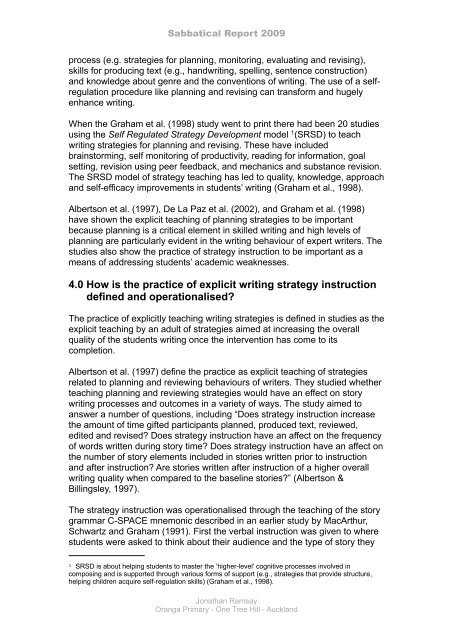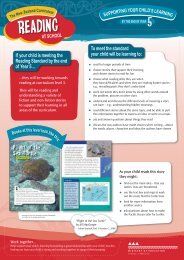Sabbatical Report - Oranga School Website
Sabbatical Report - Oranga School Website
Sabbatical Report - Oranga School Website
You also want an ePaper? Increase the reach of your titles
YUMPU automatically turns print PDFs into web optimized ePapers that Google loves.
<strong>Sabbatical</strong> <strong>Report</strong> 2009<br />
process (e.g. strategies for planning, monitoring, evaluating and revising),<br />
skills for producing text (e.g., handwriting, spelling, sentence construction)<br />
and knowledge about genre and the conventions of writing. The use of a selfregulation<br />
procedure like planning and revising can transform and hugely<br />
enhance writing.<br />
When the Graham et al. (1998) study went to print there had been 20 studies<br />
using the Self Regulated Strategy Development model 1 (SRSD) to teach<br />
writing strategies for planning and revising. These have included<br />
brainstorming, self monitoring of productivity, reading for information, goal<br />
setting, revision using peer feedback, and mechanics and substance revision.<br />
The SRSD model of strategy teaching has led to quality, knowledge, approach<br />
and self-efficacy improvements in students’ writing (Graham et al., 1998).<br />
Albertson et al. (1997), De La Paz et al. (2002), and Graham et al. (1998)<br />
have shown the explicit teaching of planning strategies to be important<br />
because planning is a critical element in skilled writing and high levels of<br />
planning are particularly evident in the writing behaviour of expert writers. The<br />
studies also show the practice of strategy instruction to be important as a<br />
means of addressing students’ academic weaknesses.<br />
4.0 How is the practice of explicit writing strategy instruction<br />
defined and operationalised?<br />
The practice of explicitly teaching writing strategies is defined in studies as the<br />
explicit teaching by an adult of strategies aimed at increasing the overall<br />
quality of the students writing once the intervention has come to its<br />
completion.<br />
Albertson et al. (1997) define the practice as explicit teaching of strategies<br />
related to planning and reviewing behaviours of writers. They studied whether<br />
teaching planning and reviewing strategies would have an effect on story<br />
writing processes and outcomes in a variety of ways. The study aimed to<br />
answer a number of questions, including “Does strategy instruction increase<br />
the amount of time gifted participants planned, produced text, reviewed,<br />
edited and revised? Does strategy instruction have an affect on the frequency<br />
of words written during story time? Does strategy instruction have an affect on<br />
the number of story elements included in stories written prior to instruction<br />
and after instruction? Are stories written after instruction of a higher overall<br />
writing quality when compared to the baseline stories?” (Albertson &<br />
Billingsley, 1997).<br />
The strategy instruction was operationalised through the teaching of the story<br />
grammar C-SPACE mnemonic described in an earlier study by MacArthur,<br />
Schwartz and Graham (1991). First the verbal instruction was given to where<br />
students were asked to think about their audience and the type of story they<br />
1 SRSD is about helping students to master the ‘higher-level’ cognitive processes involved in<br />
composing and is supported through various forms of support (e.g., strategies that provide structure,<br />
helping children acquire self-regulation skills) (Graham et al., 1998).<br />
Jonathan Ramsay<br />
<strong>Oranga</strong> Primary - One Tree Hill - Auckland




